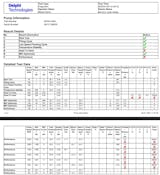The fuel injection pulse width is the length of time that the engine microcomputer controls each fuel injection, and it is the most important indicator of whether the fuel injector is working normally. The numerical unit of the fuel injection pulse width displayed by this parameter isms. The value displayed by this parameter is large, which means that each time the injector is opened for injection, the engine will get a richer mixture; the value displayed by this parameter is small, which means that the time for each injector to be opened for injection is shorter, The engine will get a leaner mixture. There is no fixed standard for the fuel injection pulse width, it will vary with the engine speed and load.
The main factors affecting the injection pulse are as follows:
(1) λ adjustment;
(2) The mixed gas concentration of the activated carbon tank;
(3) Air temperature and density;
(4) Battery voltage (how fast the injector opens).
The common reasons for excessive fuel injection are as follows:
(1) The airflow meter is damaged;
(2) The throttle control unit is damaged;
(3) There is an extra load;
(4) A certain cylinder or several cylinders are not working well.
Application of Fuel Injection Pulse Width in Automobile Fault Diagnosis
1. Use the pulse width to diagnose the fuel feedback control system
Run the engine for more than 5 minutes to enter the closed-loop control state, and the oxygen sensor signal participates in the engine feedback system. Turn off all auxiliary electrical equipment and measure the fuel injection pulse width.
1.1 Remove the vacuum tube of the oil pressure regulator and plug it with a soft plug to prevent leakage of the intake system. At this time, the speed rises, try to block the oil return pipe, and artificially increase the oil pressure. If the feedback system is normal and the oxygen sensor is normal, it can be seen that the fuel injection pulse width is reduced, generally 0.1-0.2ms. This is because the computer is too thick. The result of the mixed gas correction.
1.2 Causes vacuum leakage and makes the mixture too thin. If the system works normally, the pulse width will increase by 1.01--1.04ms, which is the result of ECU's compensation for the lean mixture.
The function of the oxygen sensor at idle speed is ignored for the old models, and the above test is carried out at 1800r/min.
Application of fuel injection pulse width in automobile fault diagnosis (2)
2. Use the idle pulse width to diagnose the oil circuit
2.1 When the hot car is running at normal idling speed, the pulse width is generally 1.5ms--2.9ms. If the pulse width reaches 2.9-5.5ms, the nozzle is generally blocked. After the new car has been running for a period of time, the nozzles are blocked in different degrees, which reduces the fuel injection volume. The computer thinks that the air-fuel ratio increases (ie lean) and the idle speed decreases. It will correct the fuel injection pulse width and the idle speed control signal to make the idle speed reach the target Speed value. This cycle is repeated, and the idle pulse width becomes larger and larger. At the same time, the engine control computer will store the position of the idle speed control valve (the number of steps of the stepping motor, or the duty cycle signal of the pulse valve) at this time for reference during the next start. Because the degree of clogging of the nozzles of each cylinder is different, and the fuel injection pulse width provided by the engine control computer to the nozzles is the same, it causes the phenomenon of unstable engine operation, insufficient power, poor acceleration, and increased fuel consumption. At this time, a good washing machine can basically solve the above problems.
Example: Times Superman Before cleaning, pulse width 3.31ms, after cleaning, pulse width 1.70ms
It should be noted that after the newly cleaned nozzle is loaded into the vehicle, the engine speed will increase convergently. This is due to the result of the ECU's long-term fuel correction. It memorizes the data since learning to control the idle speed and make the mixture too rich. Here is an In the process of re-learning, the learning time varies depending on the model. Some cars can take a few seconds, while some cars take longer.
1. For cars with clean nozzles, if the idle pulse width is still very large, and the data stream has determined that the airflow meter, intake pressure sensor, oxygen sensor, and cooling water temperature sensor are all correct, then the root cause of the fault is likely to be low fuel pressure It is caused by the fuel pressure gauge to determine the fault of the fuel pump or the fuel pressure regulator. It should be noted that after the newly cleaned nozzles are installed in the vehicle, the engine speed will increase convergently. This is due to the result of long-term fuel correction of the ECU. In the process of re-learning, the learning time varies depending on the model. Some cars can take a few seconds, while some cars take longer.
2. For cars with clean nozzles, if the idle pulse width is still very large, and the data stream has determined that the airflow meter, intake pressure sensor, oxygen sensor, and cooling water temperature sensor are all correct, then the root cause of the fault is likely to be low fuel pressure It is caused by the fuel pressure gauge to determine the fault of the fuel pump or the fuel pressure regulator.




